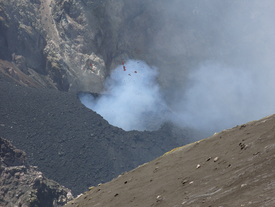|
I am now a few weeks into my PhD and am enoying it tremendously, it's certainly great enjoying what you do! As my PhD is based around gases and their importance in volcanic systems worldwide, I thought I would produce a series of posts on why they are important in specific volcanic eruption types and touch upon what they can tell us outside of eruptions.  Firstly, a brief discussion on Strombolian eruptions. The classic example of the Strombolian eruption is from the Island of Stromboli, Italy and I am sure if you search google images you will find many wonderful images of the result of a Strombolian eruption, however, what causes these eruptions? The cause of a Strombolian eruption is generally accepted to be the result of the movement of a large gas bubble (or slug as it is sometimes called) up a volcanic conduit and subsequently bursting at the surface, hence throwing the hot material out in a spectacular fashion. There is some debate about the origin of these bubbles, whether they are the result of the coalescence of bubbles (the merging of bubbles) as they rise up the conduit from depth or whether they are the result of a collection of gases which create a foam (high proportion of gas to magma) at a point at depth beneath where the surface where this could occur. At depth, however these bubbles are formed, the size is constrained by the pressure they are under. As the bubble rises, faster than the magma which it is in, it begins to grow in size and accelerate as a result, allowing a high enough velocity to eject material at the surface.Evidently a gas bubble of insufficient size will not result in a Strombolian eruption but can still burst at the surface and contribute to a phenomenon known as passive degassing (which I will refer to in a later pos)t. Strombolian eruptions can occur on timescales of seconds to minutes to hours or more and are generally associated with less viscous (more runny) basaltic magamas at high temperatures of around or more than 1100 degrees celsius. I hope you have enjoyed my very brief overview of Strombolian eruptions, any questions please post and I will try to answer! |
Archives
July 2023
|

 RSS Feed
RSS Feed